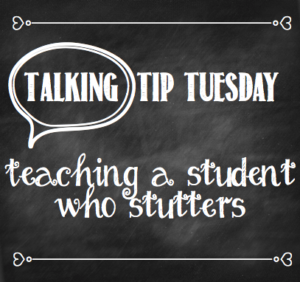Today’s Talking Tip Tuesday is for primary/elementary school teachers who have a student in their classroom who stutters. For many people who have never met someone who stutters, it can be difficult to know how to act or what to do to help. As a teacher, it is even more important to respond and behave appropriately when interacting with your student who stutters. Below are some general guidelines to follow. These guidelines have been adapted from the British Stammering Association’s website.
Build the child’s self-esteem
If the child is aware of his stutter, it can have a negative effect on his self-esteem. Praise the child when he answers questions, stays on task, helps others, etc. By building the child’s self-esteem, you can help him to speak with confidence even when stuttering severely.
Model a slow, non-rushed manner of speaking
Slow down your own speech with natural pauses, demonstrating that there is no need to rush. When the child is speaking, give time to finish and do not interrupt or try and finish off what he is saying. Often a stutter can get worse if the child speaks fast or is feeling rushed while speaking.
Be patient and interact as you would with any other student
Maintain normal eye contact and do not show any impatience. For example, avoid looking at your watch, frequently nodding, or engaging in other tasks while the student is talking. These behaviours can make the child feel rushed or that what he is saying is not important.
Listen Attentively
Actively listen to what the child is saying and repeat back some of the content so that the child feels that what he says is more important than how he says it.
Create a supportive environment
Ensure that the child’s peers in the classroom are supportive with their speaking, listening and behaviour. Teaching the values of patience, empathy, and acceptance will help all of the students including the child who stutters.
Employ fluency strategies if applicable
Speak to the child and the child’s parents to discuss what helps his speech come out more smoothly. If the child is seeing a Speech and Language Therapist, have a quick chat with her and find out what strategies you can employ in the classroom to increase fluency.
That’s all for now folks!


